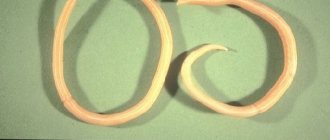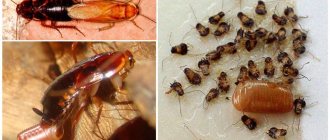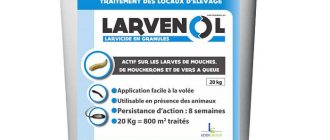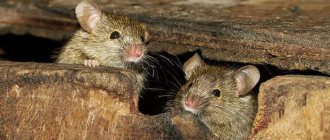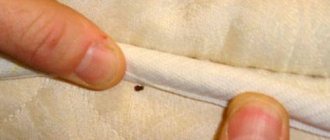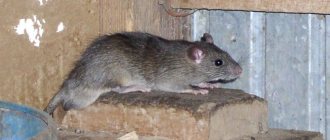Ascaris - a dangerous worm, capable of parasitizing the human body and harming its health. Ascaris eggs cause ascariasis, a common disease that is diagnosed in both children and adults. Is it possible to protect yourself from roundworms and how to do it correctly? You will find the answer to this question in our article.
Why are roundworm eggs dangerous?
Description with photos
What do roundworm eggs look like and what is inside them? In the photo, roundworm eggs appear small and inconspicuous. This is true. to see the eggs of the human roundworm with the naked eye. Photos of roundworm eggs indicate that they come in different shapes and sizes.
The cellular center in the roundworm egg contains an oval-shaped nucleus. This is important, since the principle of reproduction of this parasite is based on mitosis. Mitosis in the roundworm egg is a type of indirect cell division. If you want to study all stages of mitosis, use a crushed roundworm egg . A large number of dividing cells can be found in it.
Take a look at the photo of roundworm eggs :
Roundworm eggs
The photo shows mitosis in an roundworm egg under a microscope :
Mitosis in an roundworm egg under a microscope
In the photo below you can see a diagram of the interphase and mitotic phases in a crushed roundworm egg :
Interphases and mitotic phases in a crushed roundworm egg
What do parasite eggs look like?
Many people have no idea what it is until they see roundworm eggs. No matter how hard you try, it is impossible to detect them on your own until they develop into larvae.
Detecting parasites is not so easy , especially if the disease is in its early stages. Roundworm eggs, including unfertilized eggs, cannot be seen without a microscope. If you don't regularly test your stool, you won't notice them.
Photos of roundworm eggs can only be seen under a microscope; they will be presented below in our article.
Other visible signs of the onset of the disease are usually not noticed immediately - they are so insignificant. Therefore, in most cases, infection with ascariasis is not noted at the first stage.
Ascaris eggs under a microscope, as in the photo above, look like round or oval fragments, their color is brown or yellow.
Average sizes can be 50-70 microns. They are covered with five shells, the task of which is to provide protection from the action of antibodies contained in human blood and other aggressive environments.
Parasitism and reproduction
The development of larvae from eggs laid by roundworms occurs directly in the human body. Once in the intestine, the larva sheds its egg membranes and dissolves them by secreting its own enzymes. The parasites that hatch from the eggs are pinkish or reddish colored roundworms.
The larva has a hook-shaped process, due to which it digs into the small intestine. It then penetrates the blood vessels. Through the bloodstream, the larva ends up in the liver, respiratory organs, and brain.
The development of larvae from eggs laid by roundworms occurs at a temperature of 37 °C. The larva enters the maturation phase 8-15 days after entering the intestine. Its total lifespan in the human body is one year.
Constant reproduction is an essential condition for the life of an adult parasite. The fragmentation of the roundworm egg occurs in the uterine cavity. 240,000 is how many eggs a female roundworm lays every day. All of them are excreted into the external environment along with feces.
Migration stage of ascariasis
The migratory stage of ascariasis lasts 7-15 days. After infection, roundworm larvae migrate. At the sites where the larvae invade the liver and lungs, hemorrhages and foci of inflammation with a large number of eosinophils occur. Foci of infiltration in the lungs are unstable and often change configuration. Eosinophils in the blood increase to 15-35%, rarely - to 60% and above. The temperature is often normal or low-grade. The migratory stage of ascariasis is characterized by skin rashes: urticaria, small blisters on the palms and soles, etc.
If there are not many larvae, patients may complain of general malaise, fatigue, tingling or chest pain, and a dry, scratchy cough.
When a large number of larvae migrate, long-term bronchopneumonia with pleurisy and hemoptysis occurs.
| Photo. A - severe bilateral bronchopneumonia in a child in the pulmonary stage of ascariasis; X-ray shows multiple focal infiltrates in the lungs. B - eosinophilic infiltrate around the roundworm larva in the lungs. B - roundworm larva in the alveoli. | ||
Case from life: A 2-year-old boy has a temperature of up to 39° and a cough with sputum. X-ray revealed multiple focal infiltrates in the lungs. A diagnosis of pulmonary tuberculosis was made. However, after a few days the patient felt well. A repeat X-ray did not reveal any infiltrates. Conclusion: the child had clinical manifestations of the early pulmonary stage of ascariasis.
Symptoms of presence in the body
Symptoms of roundworm infection
The first symptoms of roundworm infection appear 1-2 months after the eggs enter the intestines. It is important to understand that in some people the early stage of development of parasites in the body is not accompanied by pronounced symptoms. However, in most cases, infected people experience:
- headache;
- weakness in the body;
- fast fatiguability;
- heat;
- allergic reactions, including itching and rash.
Sometimes infection is accompanied by pulmonary disorders . It can be:
- intense pain in the chest area;
- cough;
- sputum production;
- shortness of breath.
Pulmonary disorders due to roundworm infection
The late stage of the disease rarely occurs without symptoms. Many infected people complain of:
- problems with gastrointestinal function;
- pain in the abdomen and right hypochondrium;
- nausea;
- chest discomfort;
- asthenic condition;
- nervous system disorders;
- sudden weight loss.
Life cycle of roundworm
The life cycle occurs in several different stages.
Once worm eggs penetrate water or soil, they can remain viable for up to 7 months.
Penetrating into the human body, they initially enter the small intestine, where the larvae hatch.
The larvae then penetrate the circulatory system and spread throughout the body.
They can linger in the respiratory organs for a long time, since they need oxygen for normal functioning.
After about a week, the larvae of worms begin to severely irritate the respiratory system, causing a cough with sputum production.
Thus, the larvae are re-ingested and penetrate the intestines.
If two individuals of different sexes live in the small intestine, then after a certain time fertilization occurs and the life cycle of the worms repeats.
Many people are interested in how many eggs one adult female roundworm lays daily and how many of them are fertilized.
The number of eggs laid per day can reach more than 200 thousand, however, only a little more than half of them are fertilized.
Diagnostics
How is diagnosis carried out and is it possible to identify the disorder yourself using photos of roundworm eggs in feces?
what roundworm eggs look like in feces , since they are visible only under a microscope. , it makes no sense to search the Internet for photos of roundworm eggs in feces If you notice symptoms of parasite infection, you should immediately seek diagnostics.
Roundworm eggs under a microscope
To diagnose ascariasis in modern medicine, several methods are used at once. If a doctor suspects a patient has an intestinal form of the disease, he asks him to have his stool tested. Photos of roundworm eggs in feces under a microscope do not look very nice, so in this article we will do without them.
Ascaris eggs in feces can be fertilized or unfertilized. The presence of fertilized roundworm eggs in feces indicates that both males and females live in the human body. This is dangerous for others, since after leaving the intestines, fertilized eggs end up in the soil. If unfertilized roundworm eggs , a person does not pose a danger in terms of infection, but still requires treatment.
For diagnosis, the ELISA method or, as it is also called, enzyme immunoassay is also used. With the development of the pulmonary form of ascariasis, doctors detect parasite larvae in the sputum of patients.
Roundworms under a microscope: photos and study features
materials » Microscopes » Articles about microscopes, microspecimens and studies of the microworld » Roundworms under a microscope: photos and study features Roundworms
are human parasites, roundworms, which, when infecting the body, most often settle in the lumen of the small intestine. Although they can choose other organs as their home - the liver, heart, brain, lungs, and use blood to migrate from one place to another. Roundworms are not fatal to humans, but they greatly reduce the quality of life and pollute the body with the products of their vital activity.
Roundworms are heterosexual parasites, and a healthy female can lay about 200,000 eggs per day. Ascaris eggs can be detected under a microscope - we will not attach photos to the article, as they are quite unpleasant. But often this study is not enough to make an accurate diagnosis. The fact is that only male individuals can live in the body, and in this case, roundworm eggs cannot be seen under a microscope - they simply will not be there.
How do you even understand that your body is infected with parasites? The symptoms are quite vague, so even doctors do not always quickly determine this. The most common symptoms: upset stool, nausea, fever, weakness, dry cough, nervousness. Agree, this is suitable for many different diseases. If you suspect a helminthic infestation, you must visit a doctor, conduct a comprehensive examination of the body and take the necessary medications (they are prescribed only by a doctor).
What does roundworm look like under a microscope? In fact, an adult can be seen with the naked eye - mature parasites can reach a length of 45 cm (usually 25–30 cm). Outwardly, they resemble ordinary worms, yellowish-white in color with a matte, opaque shell. But to identify parasite eggs, you already need a microscope, but not necessarily a professional one - a modest magnification of 10 times is enough. Ascaris eggs under a microscope (you can find photos on the Internet) look like oval (sometimes round) formations about 75–85 microns long and about 35–50 microns wide.
In our online store you will find a large selection of microscopes for performing a variety of tasks, including for conducting laboratory research and identifying parasitic infestations.
4glaza.ru May 2018
Use of the material in its entirety for publicly accessible publication on media and any formats is prohibited. It is allowed to mention the article with an active link to the website www.4glaza.ru.
The manufacturer reserves the right to make any changes to the price, model range and technical specifications or to discontinue production of the product without prior notice.
recommended products
- Microscope Bresser Junior Biotar 300x-1200x, in case RUB 6,590.
- Levenhuk Rainbow 50L PLUS Moonstone Microscope\Moonstone RUB 13,990
- Microscope Levenhuk LabZZ M101 Amethyst\Amethyst RUB 3,990
Treatment
To drive parasites out of the body, the doctor prescribes anthelmintic medications to his patient. They are highly effective at all stages of pathology development, but have certain contraindications and side effects. In some cases, surgical intervention is prescribed.
Anthelmintic drugs
Lack of timely treatment has serious consequences. This can be intestinal obstruction, asphyxia, jaundice and even acute pancreatitis. To avoid all this, it is enough to sign up for a diagnosis in time and undergo the treatment prescribed by a specialist. The effectiveness of therapy can be easily determined by examining stool.
Precautionary measures
Roundworm eggs pose a great danger to humans. Fortunately, it is possible to eliminate the risk of infection by them. To do this, just follow simple recommendations:
- wash your hands thoroughly before eating;
- rinse greens, vegetables, fruits and berries before eating them;
- do not allow the child to lick dirty toys, and also closely monitor him on the street (for parents);
- Take prophylactic anthelmintic medications (for people who live in areas where parasites are widespread).
